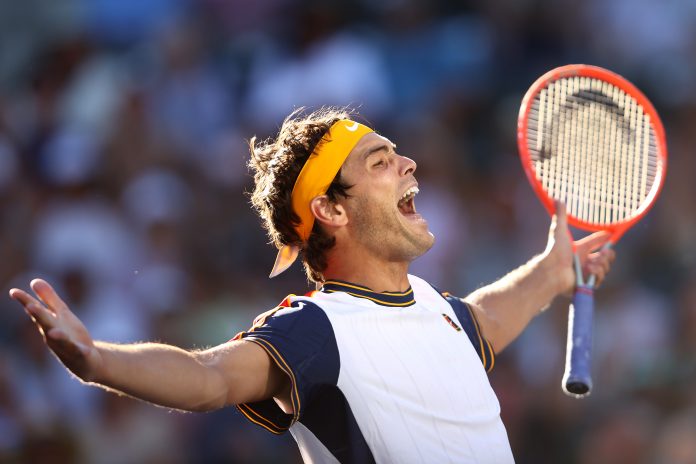Bill Simons
When fans come out to see World TeamTennis at Indian Wells November 13-28, they’ll see an array of stars on five different teams: the San Diego Aviators with rising good guy Taylor Fritz; defending champions the New York Empire with beloved Kim Clijsters and Jack Sock; the Orange County Breakers with big John Isner and the appealing Amanda Anisimova; 2020 runner-up the Chicago Smash featuring Sloane Stephens and the game’s most charismatic star, Frances Tiafoe; and the perpetually overachieving Springfield Lasers, with Mackie McDonald.
But what many don’t know is the improbable, unstoppable and ever-changing history of WTT. It’s not just that last year the league got through COVID at the Greenbrier in West Virginia and will now be offering its third format in three years. It’s more that WTT could be the greatest, grittiest and gutsiest survivor in the long, curious history of rebel sports leagues.
There’s football’s XFL, the Arena League and the United States Football League, the American Basketball Association, the World Hockey Association, the Women’s United Soccer Association and the beloved Roller Hockey International, to name a few.
The memorable tale of the rollicking early years of World TeamTennis is told with zest in Steven Blush’s eminently readable Bustin’ Balls, published by Feral House. The veteran writer shares the jaunty tale of an upstart, against-the-grain league that emerged at “an incredible time and place” in 1974. Blush writes, “Like all revolutions, it was way ahead of its time, although it makes sense today.”
The far from prim and proper WTT was seen as an assault on the traditional game. Here was a “Noise please!” league of upstart game changers with new rules, outlandish experiments and household names like Jimmy Connors, Bjorn Borg and Martina Navratilova. One year the LA Strings had a lineup featuring the irrepressible Romanian bad boy Ilie Nastase and American girl next door Chris Evert, India’s Amritraj brothers and a teenager from the Bay Area, Japanese American Ann Kiyomura.
The league had African-American, gay and transsexual players and famously played on a multi-colored court with a “We will, we will, rock you!” ‘tude. The brainchild of Billie Jean King, WTT was led by an eclectic mix of first-time owners: Volvo dealers, an oil man or two and, of course, an orthodontist.
From its ranks emerged two of the most important franchise owners who went on to create mighty fiefdoms: the Patriots’ Bob Kraft and the Lakers’ Jerry Buss.
The league also gave us some of the best team names in sports history: the Houston E-Z Riders, the Boston Lobsters, the Florida Flamingos, the Schenectady County Electrics, the Hawaii Leis, the San Diego Friars and the New York Apples, whose star, Vitas Gerulaitis, wore No. 54 to honor the infamous celebrity-disco nightclub, Studio 54.
A team of Russians called the Soviets, that played all its matches on the road, battled the Seattle Cascades in Tacoma. Elton John played against Bill Cosby at half-time. There were obscure bar fights, many ill-fated romances and a marriage or two.
To some zealots, the WTT was almost a religious experience – and mixed doubles was at its spiritual core. Equal opportunity was WTT’s first commandment; “Thou shalt be inventive” was the second.
Here, few rules and hidebound traditions were safe from scrutiny – surprises abounded.
It was no wonder, says Blush, that there was push back. “The tennis establishment had a bug up its ass. It felt WTT was cutting into their business. They felt it was an ugly Americanization of tennis. A bastardization of the sacred game.”
So the crusty, don’t-mess-with-City-Hall establishment battled back. WTT players were banned from some of the majors. The league never got the big TV contracts that were so essential. The Philadelphia Freedom did attract 15,000 fans to the Spectrum Arena, but attendance would begin to dwindle.
Mismanagement by a cadre of first-time owners had its impact, and the league folded in 1978.
But that was a just a speed bump along this very long, very jolly road. In 1981 WTT was reborn, and teams from the Rollers in Vegas to the Kastles in Washington to the Capitals in Sacramento have bravely and boldly fought on ever since.
On November 13, WTT will again emerge on Indian Wells’ oh-so-appealing Stadium 2.
Last year the WTT season came down to a single point that ultimately gave Luke Jenson’s New York Empire the title. It couldn’t have been more exciting.
Then again, excitement is WTT’s coin. Over the years the loud, rowdy, fun-loving and ever-naughty WTT has been perhaps the greatest survivor in tennis history.
With all its plot twists, free-form imagination, ample dysfunction and power of renewal, it has for decades served up compelling tennis with a twist.
For tickets, visit https://wtt.com/tickets-2021/ and use promo code INSIDE15 at checkout to receive 15% off your purchase.





















